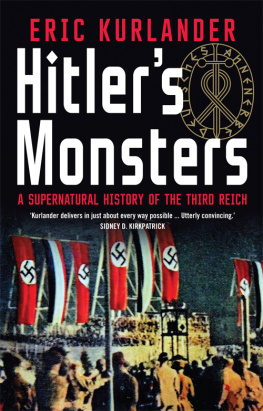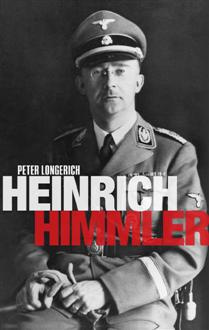HIMMLERS

HIMMLERS

LOYAL TO THE
DEATHS HEAD
ROBIN LUMSDEN

First published in 1997 as Himmlers Black Order 1923-45
This edition first published 2009
The History Press
The Mill, Brimscombe Port
Stroud, Gloucestershire, GL5 2QG
www.thehistorypress.co.uk
This ebook edition first published in 2013
All rights reserved
Robin Lumsden, 1997, 1999, 2005, 2009, 2013
The right of Robin Lumsden to be identified as the Author of this work has been asserted in accordance with the Copyright, Designs and Patents Act 1988.
This ebook is copyright material and must not be copied, reproduced, transferred, distributed, leased, licensed or publicly performed or used in any way except as specifically permitted in writing by the publishers, as allowed under the terms and conditions under which it was purchased or as strictly permitted by applicable copyright law. Any unauthorised distribution or use of this text may be a direct infringement of the authors and publishers rights, and those responsible may be liable in law accordingly.
EPUB ISBN 978 0 7524 9722 8
Original typesetting by The History Press
C ONTENTS
I NTRODUCTION
The SS is one of the best known, yet least understood, organisations in history. To most people, it was simply a brutal arm of the Nazi state which had subjugation by terror as its sole purpose. Consequently, it will forever be equated with concentration camps, torture and mass extermination, and on that basis is fated to be almost universally loathed and detested for generations to come.
Yet this dark side is only part of the SS story. The whole saga is considerably more complex and, in many ways, almost defies belief. In ten years, the SS grew from a small, unpaid bodyguard for a minor politician to a force which dominated the racial, cultural and professional spheres of the most powerful empire mainland Europe has ever seen. All the domestic police agencies of the occupied territories were controlled by the SS, and a network of monopolistic business enterprises gave the organisations hundreds of factories direct access to their own raw materials, labour and internal markets. People in all walks of life, from farmers and soldiers to academics and members of the aristocracy, flocked to join the SS for their own selfish ends.
At the centre was Himmler, a ruthlessly ambitious idealist. From the day he took command, Himmler was the SS and the SS Himmler. The organisations progress became bound up with the career of its Reichsfhrer, who obtained one important post after another until by 1945 he had concentrated more power in his person than any other man except Hitler. Wherever Himmler secured a position, he took the SS with him. The SS became both the basis and the instrument of his strength. At the height of his influence, Himmler was Chief of Police, Reich Minister of the Interior, an NSDAP Reichsleiter, a Member of the Reichstag, Reich Commissioner for the Consolidation of Germanism, Commander-in-Chief of the Home Army, Chief of Military Armament and Commander of Army Groups on the Rhine and Vistula. In effect, he and his SS controlled all forces, military, paramilitary and police, on the German home front during the Second World War.
Yet, with his crippling fascination for genealogy, medievalism and Germanic lore, the Reichsfhrer-SS exercised total control over a juggernaut which he regarded not as a political vehicle but as a racial Order. So far as Himmler was concerned, the SS was first and foremost a multi-national family, a nordic clan which would eventually unite the Germanic peoples of Europe so that they would never again come into mutual conflict. Himmler planned that after the victorious conclusion of the war, that last great war of extermination in which the SS would prove itself through the achievements of its own battlefield units, he and his successors would build up the Order and produce the leaders to direct industry, agriculture, politics and the activities of the mind in a new pagan Europe, policed and guarded by the SS.
For his part, Adolf Hitler was content to allow his loyal followers fancies free rein, since he never needed to threaten would-be troublemakers with anything other than being handed over to Himmler. The knowledge that the all-powerful Reichsfhrer was lurking around as a sort of bogeyman was usually enough to ensure that Hitler received only fawning adulation from all but the strongest willed. As a result, Himmlers personal hopes and dreams for the SS, however unrealistic, were permitted to shape the development of the entire organisation.
In writing this book, I hope to clear up some misconceptions and show that the SS had many more facets than those generally known. Within Germany itself during the Third Reich, the SS held a unique position. It was feared, yet it was also genuinely respected and, in some cases, even revered. SS membership was something to be highly valued, and the carefully designed uniforms and accoutrements intended to set the new lite apart became instant status symbols in the emerging empire. The extremely powerful influence of badges and regalia should never be forgotten when trying to seek answers to the often-asked question of why ordinary, law-abiding citizens happily subscribed to what is now generally regarded as a murderous organisation.
Robin Lumsden
Cairneyhill, March 1997
1. O RIGINS AND E ARLY
D EVELOPMENT
The origins of the SS are linked inextricably with the events and aftermath of the First World War. This epic conflict had a profound effect upon Adolf Hitler, who, after years of aimless drifting in Vienna and Munich, suddenly found his true vocation fighting on the western front. From the very beginning the German army, unlike that of Great Britain, actively encouraged initiative on the part of its NCOs and private soldiers, so Gefreiter Hitler was more than accustomed to making front-line decisions in his deputy officer capacity. As a trench messenger, he constantly ran the gauntlet of British and French machine guns, receiving the Bavarian Military Cross of Merit 3rd Class and a Regimental Citation for Bravery in the Face of the Enemy. He was wounded twice, gassed, temporarily blinded and emerged with the Iron Cross 1st Class, an unusually high decoration for an enlisted man and one which he wore proudly until the day of his death.
Once the stalemate of trench warfare had set in, Germany was quick to realise the potential of developing lite units of hand-picked infantrymen to act as assault parties and trench raiders. Early in 1915 Major Eugen Kaslow, a pioneer officer, was tasked with evaluating experimental steel helmets, body armour and a new light cannon. To do so, he formed a small assault detachment which came to be known as Sturmabteilung Kaslow. Under his leadership and that of his successor, Hauptmann Willi Rohr, the Sturmabteilung evolved new tactics to break into an enemy trench system. Combat operations in the Vosges mountains that autumn suggested that these ideas were sound and, in January 1916, Sturmabteilung Rohr was duly transferred to Verdun. At that time, the detachment comprised three-man teams called Stosstruppe, or shock troops, whose method of attack involved storming a trench in flank. The first of the trio was armed with a sharpened entrenching tool and a shield made from a machine gun mounting. He was followed by the second man carrying haversacks full of short-fused stick grenades, and the third soldier armed with a knife, bayonet or club. The Stosstruppe technique proved so successful that a number of Sturmkompanie, or assault companies, were soon formed and attached to divisions on a permanent basis. By 1918, most German armies on the western front had expanded units known as Sturmbataillone or assault battalions, each comprising an HQ company, four assault companies, an infantry artillery company armed with the 37 mm Sturmkanone, a machine gun company, a light trench mortar detachment and a flamethrower detachment.
Next page






